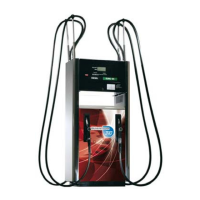
Do you have a question about the Tokheim Quantium 310 and is the answer not in the manual?
| Model | Quantium 310 |
|---|---|
| Display Type | LCD |
| Power Supply | 230 V AC |
| Frequency | 50 Hz |
| Power Supply (DC) | 24 V DC |
| Storage Temperature | -40°C to +70°C |
| Humidity | Up to 95% non-condensing |
| Weight | Varies by configuration |
| Application | Petrol Dispenser |
| Number of Products | Up to 4 |
| Number of Nozzles | 1 or 2 |
| Payment Options | Cash, Card, Fleet Card |
| Keyboard | Numeric keypad |
| Meter Type | Electronic |
| Operating Temperature | -20 to +50 °C |
| Communication | Ethernet, RS-232, RS-485 |
| Operating Temperature (Display Unit) | -20 to +50 °C |
| Dimensions | Varies by configuration |
| Connectivity | Ethernet |
Guidance on navigating and utilizing the manual's sections and content effectively.
Defines the range of fuel dispensers covered, excluding LPG versions, and their configurations.
Specifies requirements for qualified personnel to perform maintenance procedures safely and correctly.
Provides details for reaching the technical author and service departments for inquiries.
Outlines critical safety guidelines, checklists, hazards, and protective measures for safe operation.
Details the dispenser's compliance with European Directives, ATEX, and OIML standards.
Explains Metrological Instruments Directive (MID) compliance, calibration, and essential documentation.
Provides general advice, safety checks, and preparation steps before any maintenance task.
Details safety precautions for Intrinsically Safe (IS) circuits, including cable routing and segregation.
Describes how to identify dispenser sides A and B, detailing components housed in each.
Step-by-step instructions for safely opening and removing the hydraulic doors.
Detailed procedure for safely accessing the dispenser's calculator head compartment.
Instructions for safely removing side panels to access the cable glands.
Procedure for safely accessing the junction box connections on the dispenser.
Step-by-step guide for replacing the fuel dispenser nozzle, including tools and safety.
Instructions for replacing the dispenser hose, covering different mast types and tools.
Procedure for replacing a damaged Elaflex safety break coupling on the nozzle.
Guide for replacing the nozzle reed switch, detailing access and connection steps.
Instructions for replacing the external filter located in the filter box.
Procedure for changing the internal filter within the EPZ pump assembly.
Steps to replace the bypass valve assembly on the PAS V3 pump, noting spring tension.
Instructions for replacing the bypass valve assembly on the EPZ pump, including adjustment.
Guide for replacing the motor V-belt, including tension adjustment.
Procedure for replacing the pulley on the PAS V3 pump, requiring a puller tool.
Instructions for replacing the pulley on the EPZ pump, involving screw and washer removal.
Detailed steps for replacing the PAS V3 pumping unit, including connections and draining.
Procedure for replacing the EPZ pumping unit, covering variations with internal/external filters.
Comprehensive guide for replacing the dispenser motor, involving electrical and mechanical steps.
Step-by-step instructions for replacing the SM80 meter, including electrical and fluid connections.
Guide for replacing the optional spin-on filter, covering valve operation and tightening.
Identifies the electronic components typically housed in the calculator head's Side A and Side B.
Procedure for safely replacing fuses located on electronic boards or DIN rails.
Steps to replace the battery pack within the calculator head, noting polarity.
Guide for replacing the MP-T1 pulser, involving cable tracing and connection management.
Instructions for replacing push buttons, switches, or cables on the calculator door.
Procedure for replacing the Input/Output (I/O) board or Mainboard, including disconnecting all cables.
Steps for replacing Customer Sales Display (CSD) or EMT boards, involving security bracket removal.
Guide for replacing the calculator door's plexiglass and rubber seal.
Procedure for replacing Communication (Comms) or I/O Extension Boards (IEB).
Instructions for replacing the Hydraulic Option Module (HOM) Board.
Guide for replacing the programming switch on the dispenser.
Procedure for replacing the Option Controller Board (OCB) or User Access Module (UAM).
Steps for replacing the EPSI Board.
Procedure for replacing the V-belt on the ECVR unit, including motor adjustment.
Detailed steps for replacing the Durr pump on the ECVR unit, involving fittings and belt adjustment.
Guide for replacing the motor in the ECVR unit, covering electrical and mechanical connections.
Procedure for replacing the solenoid valve on the ECVR unit, involving cable tracing and gland adjustment.
Instructions for replacing the VFM unit, including disconnection of vessel and filter fittings.
Diagram illustrating hydraulic setup for models 1-1i, 1-2i, 1-2, 2-2i Single-Sided, 2-4, HS 1-2, SHS 2-2i Single-Sided.
Diagram showing hydraulic setup for models VHS 1-1i, VHSM 1-1.
Diagram illustrating hydraulic setup for model VHSM 2-2.
Diagram showing hydraulic setup for models with High Speed Motor Control.
Diagram illustrating hydraulic setup with various HCM and HDM connections.
Diagram showing hydraulic setup with multiple HCM, HDM, and optional preset buttons.
Diagram illustrating hydraulic setup for model SVHS 2-2i.
Diagram showing hydraulic setup with multiple product lines and HCM/HDM configurations.
Diagram illustrating hydraulic setup for double-sided models like 2-2i, HS 2-2i, SHS 2-2i.
Diagram depicting hydraulic setup for model 80, including oil pump and level switches.